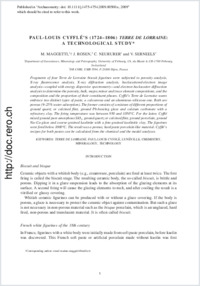Paul-Louis Cyfflé's (1724-1806) Terre de Lorraine: a technological study
- Maggetti, Marino Department of Geosciences, Mineralogy and Petrography, University of Fribourg, Switzerland
- Rosen, J. DR CNRS, Dijon, France
- Neururer, Chrisoph Department of Geosciences, Mineralogy and Petrography, University of Fribourg, Switzerland
- Serneels, Vincent Department of Geosciences, Mineralogy and Petrography, University of Fribourg, Switzerland
-
16.08.2010
Published in:
- Archaeometry. - 2010, vol. 52, no. 5, p. 707-732
English
Fragments of four Terre de Lorraine biscuit figurines were subjected to porosity analysis, X-ray fluorescence analysis, X-ray diffraction analysis, backscattered-electron image analysis—coupled with energy dispersive spectrometry—and electron backscatter diffraction analysis to determine the porosity, bulk, major, minor and trace element compositions, and the composition and the proportion of their constituent phases. Cyfflé's Terre de Lorraine wares embrace two distinct types of paste, a calcareous and an aluminous–siliceous one. Both are porous (9–25% water adsorption). The former consists of a mixture of different proportions of ground quartz or calcined flint, ground Pb-bearing glass and calcium carbonate with a refractory clay. The firing temperature was between 950 and 1050°C. For the latter, Cyfflé mixed ground pure amorphous SiO₂, ground quartz or calcined flint, ground porcelain, ground Na–Ca-glass and coarse-grained kaolinite with a fine-grained kaolinitic clay. The figurines were fired below 1000°C. The result was a porous, hard paste porcelain-like material. Cyfflé's recipes for both pastes can be calculated from the chemical and the modal analyses.
- Faculty
- Faculté des sciences et de médecine
- Department
- Département de Géosciences
- Language
-
- English
- Classification
- Engineering materials
- License
- License undefined
- Identifiers
-
- RERO DOC 12985
- DOI 10.1111/j.1475-4754.2009.00500.x
- Persistent URL
- https://folia.unifr.ch/unifr/documents/301412
Statistics
Document views: 70
File downloads:
- serneels_plc.pdf: 144
